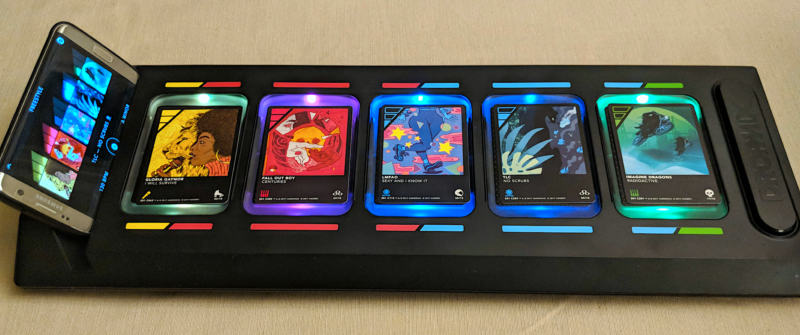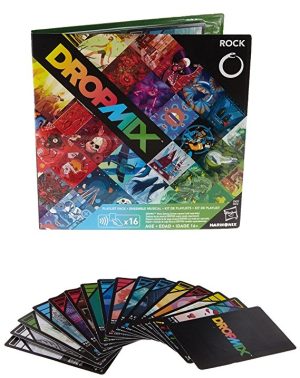
Trying to explain what DropMix is can prove a challenge. It’s a game, it’s a chunky piece of hardware, and it’s a centerpiece that breeds discussion. But it’s primarily an experience—and one that’s wholly unique.
This product is brought to us courtesy of Hasbro teaming up with Harmonix, the studio behind the massive hit Rock Band. It’s a tabletop game of sorts that facilitates the ad-hoc creation of custom music mixes. If you ever wondered what Carly Rae Jepsen’s “Call Me Maybe” would sound like when paired with the percussion from Skrillex’s “Bangarang,” DropMix has your answer. What’s surprising is just how effective this piece of technology is.
Guts of wire
There’s a simple charm to the physicality of the DropMix board. It sits in the middle of the table and, when my group played, we huddled around it and felt a Dark Tower-like nostalgia; it has a toy factor that draws a crowd and attention.
In addition to the oblong hardware, you also need a phone. This connects to the DropMix board hardware via Bluetooth and will handle the changing visuals and blasting audio, as well as the internal game logic.
The board sits quietly, waiting for you to take one of the 60 included cards and toss it onto the playing surface. Each card represents a specific instrumental track from a well-known song. So we have stuff like Young M.C. spitting fire with “Bust A Move,” the drums from Cake’s “Short Skirt/Long Jacket,” and Ed Sheeran working the guitar in “Sing.” You can place any of those cards into the color-mapped instrument slots on the board, and the resulting cacophony will be blended thanks the invisible hands of your phone’s internal sound engineer.
A sophisticated algorithm blends instrument and vocals on the fly to level out the pitch and tempo. What should be harsh dissonance is interwoven into an audio treat that is surprisingly smooth. It’s been said that you can’t make a bad song with DropMix; that’s not completely true, but it’s much harder than you’d think to make a terrible noise.
The functionality and user interaction is top-notch. The board is incredibly responsive, and the phone app reacts fluently. The app supports various play modes and even has the ability to save your creations and share them by exporting the video to your phone’s camera roll. The software has evolved over time and has continually improved with new features and extensibility.
-
Placing a card on the board.
-
Some of the 60 initial cards that come with the base game.Charlie Theel
-
You'll need a phone to play; luckily, the app is solid.
Where’s the game?
The real accomplishment of this release lies entirely in its stellar software. In order to present the experience to a consumer, Hasbro took the basic tech and tacked on a couple of play modes with rules and structure. Mostly these serve as a justification to play with a toy as opposed to finding any level of depth or success as a hobby design. Unfortunately, both formalized modes of play are inherently limited.
The competitive variant has players battling head to head in a light area control game. You place cards atop the different slots on the board in order to seize ownership of that particular color. There is a degree of depth in how you build your deck and the strategic choice to focus on certain groups of cards. There are tactical considerations in the timing of specific moves and in hitting the large DropMixbutton on the console to randomly clear portions of the playing surface.
The problem is that, as a game, you’d be much better off playing a number of other releases; Jump Drive, Codex, and Star Wars: Destinyall offer a stronger two-player competitive experience.
Co-operative is the more enjoyable of the two modes. This is a real-time reaction game where the application spits out card requirements—such as blue with a volume rating of two—and one person in the group must quickly obey and place a card. It’s all about reflexes and rapidly parsing your hand against the problem presented.
Purely as a game, this approach does achieve a level of fun. The shortcoming here is that play moves at a very quick speed. This means the audio mix shifts on a dime and never sticks around for more than a few seconds. With little time to identify and enjoy the nuances of your creation, the aural component is mostly irrelevant. In this way, it undercuts the very magic of what pulled us towards the machine in the first place.
Freestylin’
While the novelty of DropMix as a game wears off quickly, the novelty of DropMixthe toy does not. We really just want to toss out an absurd mixture of cards and marvel at our creation. This is a product which facilitates artistic creativity in a way that tabletop experiences have often lacked. Many games focus on building something, such as a city or castle, yet few actually allow us to experience our output in such an organic and fulfilling way.
The bulk of your play will consist of tinkering around in freestyle mode. You can explore different aural patterns and twist new mixes without restriction. You can sit and jam, playing make-believe DJ as you’re bumping in your dining room chair while an imaginary crowd roars in fevered exhilaration.

There is a cost for this experience, however.
While the entry point for the base game feels appropriate, you’ll soon find yourself up against a wall of expansion material. With dozens upon dozens of booster packs and playlist sets, it’s difficult to say no. And these additional card sets feel almost mandatory, as you will quickly tire of the included deck of 60 options.
DropMixis far from perfect. It’s a toy masquerading as a game. It’s a subscription service presented as a cheap one-time purchase. But it’s also a compelling accomplishment of creative expression. When a tabletop experience touches on art and culture in a meaningful way, it deserves recognition.
Listing image by Charlie Theel
reader comments
24